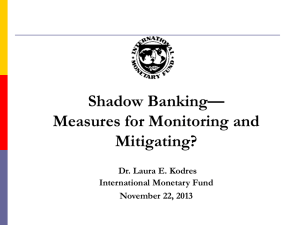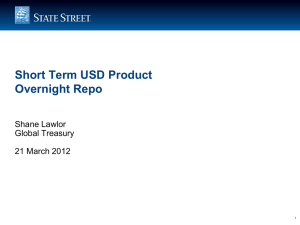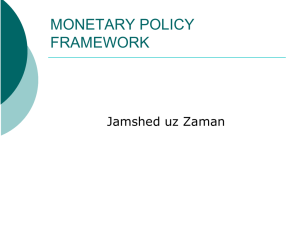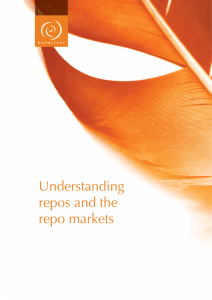Asia Securities Industry & Financial Markets Association Developing
advertisement
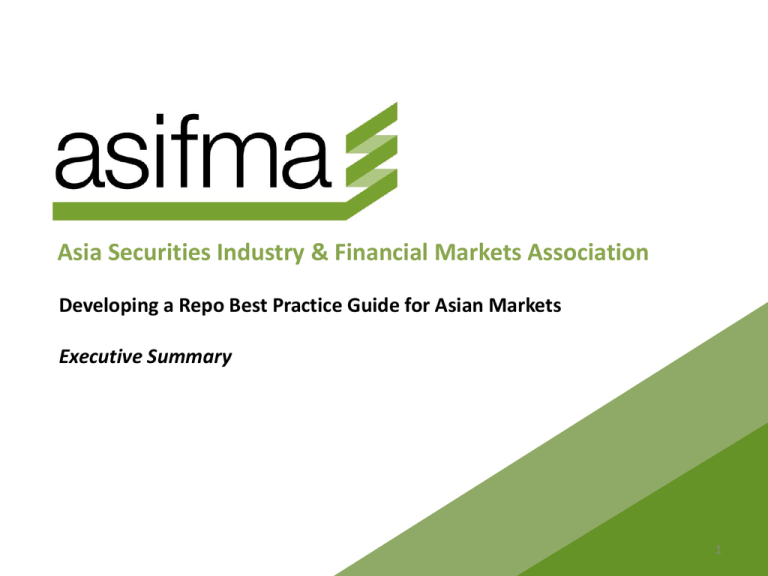
Asia Securities Industry & Financial Markets Association Developing a Repo Best Practice Guide for Asian Markets Executive Summary 1 How Repo Markets Support the Real Economy Improve market transparency Deepens primary and secondary market liquidity and thus broadens investor demand Support local currency bond market Enables investors to access bond markets and transact in local currencies, facilitates pricing and valuation of securities The Real Benefits of Repo Markets Foster investor confidence Helps to establish a benchmark yield curve and improves price discovery and transparency across short- and longterm securities Expand pool of available finance Promotes cross-border mobility of assets which increases access to funding pools across the region Contribute to effective risk management Offers hedging tools that are critical to risk management 2 3 Necessary Steps to Develop and Grow Asian Repo Markets Reform legal architecture • Provide explicit legal protections regarding creditors’ rights (to netting and liquidation of collateral assets) in bankruptcy/insolvency regimes; • Harmonize the legal definition of repo transactions to reflect the characteristics of “classic” repos (i.e. full transfer title of assets) in Asian jurisdictions; and • Recognize repo agreement documentation (such as Global Master Repurchase Agreement) in the legal frameworks to reinforce legal certainty and enforceability of underlying agreements. Improve market liquidity • • • • Increase participation from institutional investors and corporate treasurers; Improve pricing feeds and benchmarks to enhance market transparency; Increase market access for foreign investors; and Liberalize restrictions on currency convertibility and repatriation. Strengthen and integrate market infrastructures • Improve real-time price discovery access; and • Develop interoperability of key market infrastructures, such as linking onshore and offshore repo markets at ICSDs, CSDs, and Securities Settlement Systems to enable cross-border mobilization of assets. 3 Next Steps Engage policymakers, academics, multilaterals, and industry practitioners to develop and refine Best Practice Guide Finalize Repo Best Practice Guide for Asian Markets Share findings and key policy recommendations Advocate adoption of best practices to domestic market practitioners 4 Annex I: Key Issues and Recommendations Impediments Current Status Considerations Legal architecture Enforceability of repo contracts, investor protections, and bankruptcy procedures vary due to divergent legal treatment and judicial interpretations across jurisdictions (i) (ii) (iii) (iv) Divergent legal constructions of repo markets Regional differences in the legal constructions of the Repo (i.e. “Classic Repo” vs. “Buy and Sell Back,” “Pledge,” and “Borrow and Lend” models) (i) Market infrastructure Lack of pricing feeds, and linkages / interoperability between securities depositories and settlement systems across the region inhibits transparency and encumbers asset in domestic markets (i) Ensure legal frameworks reflect the underlying characteristics of repo agreements (such as the full ownership transfer of assets in “classic repos”); Incorporate protections of creditors’ rights during bankruptcy or insolvency proceedings (such as rights to liquidate collateral and net exposures in the event of counterparty default) in jurisdictions’ bankruptcy laws; and Recognize the legal agreements that underpin repo transactions (such as Global Master Repurchase Agreement) in bankruptcy and insolvency regimes; and Share information with securities regulators, tax authorities and judiciaries on repurchase agreements and the legal contracts that underpin them. Harmonize legal constructions of the repo to ensure consistency and predictability of cross-border repo transactions; and (ii) Move towards adoption of a true sale (“classic repo”) market in which the buyer maintains rights to assets and to net exposures in the event of a counterparty default. Review electronic platforms (i.e. to improve real-time price discovery access); and (ii) Improve interoperability of key market infrastructures, such as linking onshore and offshore repo markets at ICSDs, CSDs, and Securities Settlement Systems to 5 enable cross-border mobilization of assets. Annex I: Key Issues and Recommendations (continued) Impediments Current Status Considerations Liquidity issues Liquidity is impeded by: (i) Underdeveloped local currency (LCY) bond markets and lack of pricing benchmarks; (ii) Limitations to utilize bond holdings in the repo market; (iii) Restrictions on foreign investor participation; (iv) Insufficient eligible liquid assets to be traded across borders (v) Market practice of holding assets to maturity; (vi) Statutory liquidity requirements, which confine assets on balance sheets; and (vii) Low level of institutional investor participation. (i) Restrictions on currency convertibility and repatriation Restrictions on the amount of currency that can be remitted or repatriated reduces market access and participation, constraining the development of a cross-border repo market Liberalize controls to promote cross-border trade and settlement in LCY bond and repo markets and promote diversification of the investor base Tax treatment Withholding taxes, transaction taxes, stamp duties, and others increase costs and decrease liquidity in bond and repo markets Harmonize tax treatment, promote exemptions and double taxation treaties for repo market participants Market access issues Restrictions on foreign investors, or registration requirements for foreign investors deter market participation, reduce liquidity, and impede the development of a crossborder repo market Liberalize market access for foreign financial institutions across the region to enhance participation, diversify the investor base, and increase market liquidity (ii) (iii) (iv) (v) (vi) Strengthen LCY bond markets and recognize them as eligible collateral; Collaborate with Asian central banks to establish cross-border collateral arrangements to increase pool of eligible securities to be traded across borders; Liberalize market access for foreigner investors; Reduce requirements on held-to-maturity assets; Enable full title transfer of assets and subsequently the right to use those assets lengthens collateral chains and increases secondary market liquidity; and Induce participation and investment within the institutional investment community. 6 Annex II: Table of Contents of Repo Best Practice Guide – Section I Section I: Laying the Policy and Regulatory Foundation for Efficient Repo Market Development • Understanding repurchase (repo) agreements and the repurchase market • Why repo markets matter to the real economy • Role of repurchase markets in capital market development • Overview of a “classic” repurchase transaction • Types of repurchase transactions • Classic repos: Bilateral versus Tri-Party • Role of collateral in repo transactions • Importance of rights to re-use collateral assets • Necessary conditions to grow regional repo market • Legal & regulatory issues • Depth of liquidity in regional bond markets • Market infrastructure • Tax treatment • Currency barriers and exchange rate volatility • Key issues and recommendations • Deep, liquid regional bond markets • Critical components of the legal architecture governing repo markets • Consistency in legal constructions of repo • Recognition of repo documentation in legal regimes • Default protections and insolvency regimes • Market access for foreign investors, repatriation and convertibility rights • Neutrality in tax treatment • Market infrastructure connectivity • Current market dynamics in some ASEAN + 3 jurisdictions • Addressing policy and market constraints to developing a regional repo markets 7 Annex II: Table of Contents of Repo Best Practice Guide – Section II Section II: Market Conventions and Industry Best Practice across the Repo Trade Lifecycle Pre-Trade Best Practices Best Practices Over the Life Cycle of a Repo • • • • • • • • • • • • • • • • • • • • • On-boarding a repo counterparty Importance of repo documentation Best practice in initiating a repo transaction Counterparty identification Communication and messaging standards How to quote the price of a repo How to quote the Purchase Price Fixing the Purchase and Repurchase Dates Agreeing interest rates for late payments Verifying the terms of transactions Recommended delivery size Guidance for minimum call / threshold amount Margin thresholds and minimum transfer amounts Anticipating problems that may be caused by low or negative repo rates Calculating floating-rate repo interest payments Calculating open repo interest payments Settlement instructions • • • • • • • • • • • • • • • • • Role of collateral in repo transactions Recognizing the transfer of title to collateral Managing collateral in repo transactions Allocation of collateral in a general collateral (GC) repo Agreeing the price of collateral Fixing an initial margin or Haircut Agreeing rights of substitution Mark-to-Market and Margining Conventions Margin call timing (for relevant currencies) Coupon, dividend and other income payments on collateral Exercising agreed rights of substitution Confirmation and affirmation of post-trade amendments and updates to the terms of a repo The issuance of termination notices to counterparties Payment protocols / cut-offs Managing repo using tri-party services Default Management Procedures Failure to Deliver Collateral versus Event of Default Accepting Partial Deliveries Event of Default protocol Exercising a ‘mini close-out’ in response to a failure to deliver Partial Settlement versus Pairing-Offs 8 Annex III: Repo Markets Workshop – “Straw Man” Agenda Day 1 – For Senior regulators, policy-makers and public sector participants 13:35-14:05 14:05-14:35 14:35-15:05 15:05-16:00 Presentation: ABCs of Repo Markets Presentation: Why Repos Matter to the Real Economy Presentation: Roadmap Towards a Deep, Liquid Cross-Border Repo Market in Asia Panel Discussion: Meeting the Liquidity Challenge: Improving the Depth of Regional Local Currency Bond and Repo Markets Day 2 – In depth look for Industry practitioners and working-level regulators, policy-makers and public sector participants 09:05-09:35 09:35-10:20 10:20-11:05 11:05-11:30 11:30-12:15 12:15-13:00 13:00-14:00 14:00-14:45 14:45-15:30 15:30-16:15 Presentation: Importance of Developing a Deep, Liquid Cross-Border Repo Market in Asia Panel discussion: Enhancing Market Infrastructures to Support Efficient Cross-Border Pricing, Trading, Clearing and Settling of Repo Transactions Panel Discussion: Adopting Operational Best Practices in Cross-Border Repo Markets Tea and coffee break Panel discussion: Risk Management in Repo Transactions Panel Discussion: Collateral Management in the New Regulatory Landscape Lunch Panel Discussion: The Importance of the Legal Architecture of Repo Transactions Panel Discussion: Examining the Impact of the Tax and Accounting Regimes on Repo Market Activity Panel Discussion: Priorities and Recommendations to Develop a Cross-Border Repo Market in ASEAN + 3 9


